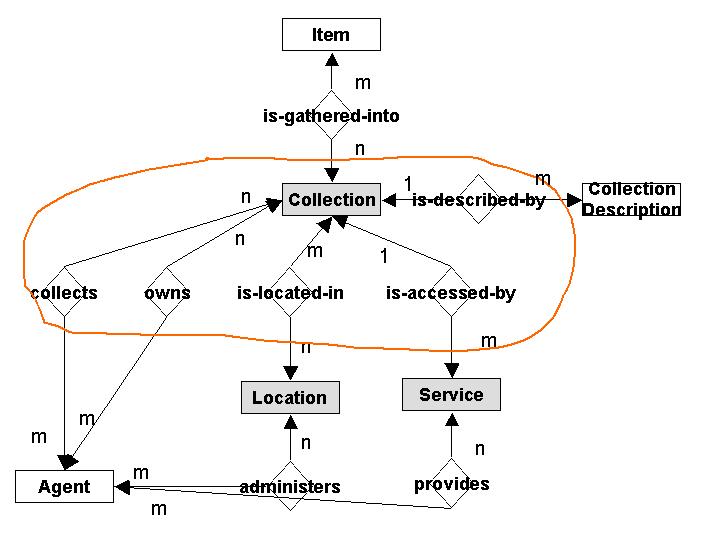Dublin Core™ Collection Description Application Profile: Data Model
| Creator: | Dublin Core™ Collection Description Working Group |
|---|---|
| Date Issued: | 2004-07-04 |
| Identifier: | http://dublincore.org/specifications/dublin-core/collection-description/collection-model/2004-07-04/ |
| Replaces: | Not applicable |
| Is Replaced By: | http://dublincore.org/specifications/dublin-core/collection-description/collection-model/2004-07-11/ |
| Latest Version: | http://dublincore.org/specifications/dublin-core/collection-description/collection-model/ |
| Description of Document: | This document discusses the data model used within the Dublin Core™ Collection Description Application Profile. |
The Data Model

Entity Types
Item
A concrete realisation of Content. An item may be physical, digital or analog.
The DC CD AP does not provide for the dsecription of the Item so does not provide a corresponding class.
Collection
An aggregation of one or more Items.
In the DC CD AP, this entity type corresponds to the class dcmitype:Collection.
Location
A place where a Collection is held.
The DC CD AP does not provide for the description of the Location so does not provide a corresponding class.
Service
The provision of, or system of supplying, one or more functions of interest to an end-user or software application.
In the DC CD AP, this entity type corresponds to the class dcmitype:Service.
In the context of the DC CD AP, the services of interest are that sub-class which provide access to Collections:
Informational Service
An Informational Service is a service that provides access to a Collection.
Agent/Party
An Agent is an entity capable of action.
The DC CD AP does not provide for the description of the Agent so does not provide a corresponding class.
Collection-Description
A resource that provides information about a Collection.
The Analytical Model [1] identifies four sub-classes of Collection Description:
Unitary Finding Aid
A Collection-Description which consists only of information about
the Collection as a whole and does not provide information about
the individual Items within it.
Hierarchic Finding Aid
A Collection-Description which consists of information about the
Collection as a whole, together with information about the
individual Items within it and their Content, including contextual
information about the relation of the Items and their Content to the
Collection as a whole.
A Hierarchic Finding Aid is itself a Collection, and may be described by a Unitary Finding Aid.
Analytic Finding Aid
A Collection-Description which consists of information about the
individual Items within it and their Content.
An Analytic Finding Aid is itself a Collection, and may be described by a Unitary Finding Aid.
Indexing Finding Aid
A Collection-Description which consists of information derived
from the individual Items within it.
An Indexing Finding Aid is itself a Collection, and may be described by a Unitary Finding Aid.
Relationship Types
Is-Gathered-Into/Is-Gathering-Of
An Item*is-gathered-into_ one or more Collections.
A Collection*is-a-gathering-of_ one or more Items.
The DC CD AP does not describe these relationships between Item and Collection, so does not provide corresponding properties.
Is-Located-In/Is-Location-Of
A Collection*is-located-in_ one or more Locations.
A Location*is-location-of_ one or more Collections.
In the DC CD AP, the Is-Located-In relationship type corresponds to the property gen:isLocatedIn (gen:location?); the DC CD AP does not provide a property to represent the inverse relationship type.
Is-Administered-By/Administers
A Location*is-administered-by_ one or more Agents who have responsibility for the physical or digital environment.
An Agent*administers_ zero or more Locations.
The DC CD AP does not describe these relationships between Location and Agent, so does not provide corresponding properties.
Is-Accessed-By/Provides-Access-To
A Collection*is-accessed-by_ one or more Informational Services.
An Informational Service*provides-access-to_ exactly one Collection.
In the DC CD AP, the Is-Accessed-By relationship type corresponds to the property gen:isAccessedBy (gen:access?); the DC CD AP does not provide a property to represent the inverse relationship type.
Is-Provided-By/Provides
A Service*is-provided-by_ one or more Agents.
An Agent*provides_ zero or more Services.
The DC CD AP does not describe these relationships between Service and Agent, so does not provide corresponding properties.
Is-Described-By/Describes
A Collection*is-described-by_ zero or more Collection Descriptions.
A Collection Description*describes_ exactly one Collection.
In the DC CD AP, the Is-Described-By relationship type corresponds to the property dc:description; the DC CD AP does not provide a property to represent the inverse relationship type.
Examples
Collection of Physical Items
A physical collection (e.g. a library collection) is located at a physical location (a library).
The location is administered by the library-as-agent.
Access to the collection is provided by a physical service (e.g. a reference service or a lending service).
The service is provided by the library-as-agent (or some subgroup).
Collection of Digital Items
Questions
Digital Location and Service
Is it possible to talk about a digital Location that is distinct from a digital Service?
Or for digital Collections, do we talk only about digital Services (and not digital Locations)?
Generalising the Model
Can the model be generalised to types of resource other than Collections?
What are the implications for existing practice (e.g. existing use of dc:identifier)?
Representation in DC
How should the (two different) relations between Collection and Service and between Collection and Location be represented in DC metadata?
- by existing DC elements or element refinements?
- by new elements for the dcterms vocabulary?
- by new refinements of
dc:relation? - by new refinements of some other DC element(s)?
What are the implications for "dumb-down"?
